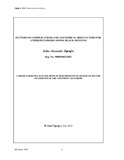| dc.description.abstract | Atherosclerotic diseases are emerging major health challenges in Kenya. Data on their patterns
and anatomical risk factors vary between countries and populations and are important for
informing appropriate management and prevention strategies, but are generally scarce from
Kenya. The aim of this study was, therefore, to describe the pattern of complications and
anatomical risk factors for atherosclerosis among black Kenyans. The study was done in two
phases: Prospective and retrospective. Prospective autopsy examination was undertaken to
describe the profile of cardiovascular causes of death including histomorphometry to determine
intimomedial thickness, luminal stenosis and diameters, and look out for features of
atherosclerosis. Cadaveric dissection and measurements were done to establish branching
patterns, bifurcation angles, bifurcation area ratios and lengths of common carotid (CCA), left
coronary (LCA), common femoral (CFA) and proximal renal arteries (PRA). Retrospective
analysis of records from Kenyatta National Hospital for patients with aneurysm, stroke,
myocardial infarction, peripheral vascular and hypertensive renal disease from January 1999 to
December 2011 was done for anatomical localization, age and gender distribution, and
comorbidities. Data were analysed using the Statistical Package for Social Sciences (SPSS) for
windows version 17.0. Descriptive statistics were applied to determine frequencies, means and
anges and standard deviations of the studied variables. Data were presented using tables, graphs,
pie charts, macrographs and micrographs.
Autopsy examination of 1200 cases of natural deaths revealed that cardiovascular disease caused
236 (19.7%) of them. Of these, 102 (43.2%) were atherosclerotic. Complications of
atherosclerosis were the cause of 102 (8.5%) of all deaths. The most common complications
included myocardial infarction (40; 16.9%), cerebral aneurysms (36; 15.3%), and aortic
aneurysms (26; 11.0%). Mean age was 43.2 years, peaking at 40 – 60 years. Fifty two (51%) of
the atherosclerotic diseases occured before 50 years. The male: female ratio was 1.5:1.
Atherosclerotic plaques, occlusive intimal hyperplasia and severe intimal hyperplasia were
present in 20 (9.4%), 34 (16%) and 53 (24.9%) of individuals respectively. Retrospective patient
data analysis revealed that aneurysms occured most commonly in the infrarenal aorta, femoral
and posterior communicating arteries. Stroke occured at mean age of 58.4 years, affected mainly
the territory of middle cerebral artery more commonly in women than in men. Coronary
atherosclerosis occured most commonly in the left anterior descending coronary artery (LAD)
causing myocardial infarction at a mean age of 56.8 years, more frequently in men than in
women. Peripheral vascular disease occured at a mean age of 60.5 years, more commonly in
men. Femoral artery was the most commonly affected site. Atherosclerosis of proximal renal
artery was the cause of end stage renal disease in 4 out of 114 (3.5%) of cases of hypertensive
renal disease. The most frequent comorbidities were hypertension, diabetes mellitus, obesity,
dyslipidemia, smoking and infections.
From cadaveric dissection of 208 specimens, the highest proportion of variant branching patterns
was in the left coronary (94; 45.2%), followed by common carotid (86; 41.3%), renal (123;
40.3%) and femoral (58; 27.8%) arteries. Mean bifurcation angles for respective arteries were
24.10 (common carotid); 24.70 (femoral); 61.90 (left coronary). Mean implantation angle of the
renal artery was 940. Mean length of left coronary, femoral and renal arteries was 8.45 mm, 43.1
mm and 31.0 mm respectively. Mean bifurcation area ratio of common carotid artery was 1.05
with 74 (35.6%) of cases being above the optimum of 1.2. Mean intimomedial thickness of the
common carotid, left anterior descending, common femoral and renal arteries was 0.86mm;
0.332 mm, 0.76 mm and 0.46 mm respectively. The IMT increased with number of branches,
bifurcation area ratio and bifurcation angle, and decreased with arterial length. It was higher in
males. Mean luminal arterial diameter for the LAD, CCA, CFA and PRA were 2.72 mm; 7.86
mm; 8.4 mm and 3.6 mm respectively. Diameter increased with number of branches and was
higher in males.
In conclusion, cardiovascular disease causes nearly 20% of deaths with atherosclerosis
constituting over 8% of overall mortality. Myocardial infarction was the most common
condition, overlapping with infectious and nutritional conditions. Complications of
atherosclerosis frequently occur in individuals aged ≤ 40 years, in males more than females.
Comorbidities included modifiable risk and lifestyle factors as well as infections and inborn
conditions. Anatomical risk factors comprising abnormal branching patterns, wide bifurcation
angles, short arterial stems, suboptimal bifurcation area ratios and high intimomedial ratios
existed in over 15% of the population. These observations indicate that atherosclerosis is a
significant problem in the black Kenyan population and vulnerability starts from birth. Control
measures should commence from early in life | en_US |
| dc.description.department | a
Department of Psychiatry, University of Nairobi, ; bDepartment of Mental Health, School of Medicine,
Moi University, Eldoret, Kenya | |

